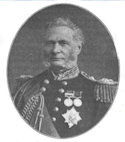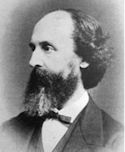Royal Naval College Greenwich Centenary 1873 - 1973
The Foundation
 The first President was the already
mentioned Vice-Admiral Sir Astley Cooper Key KCB FRS, later First Sea Lord.
'Our profession is one of action' he wrote 'nine-tenths staffed by practical
men, good seamen, with very little knowledge of what may be called book
learning. The remaining one-tenth must be this and more-highly cultivated
scientific men.' Under the guidance of Key, deliberately chosen as the Navy's
foremost example of the combination of the active and the theoretical, was to
arise an institution unrivalled by any in Europe, which distinctly raised the
scientific status of the whole Service.' Our nearest rivals, the French were
considered more scientific, we more practical. Now the Royal Navy could be
both. As the motto chosen by the President for the new College aptly defined it
- Tam Minerva Quam Marte (By Wisdom as much as War). The first President was the already
mentioned Vice-Admiral Sir Astley Cooper Key KCB FRS, later First Sea Lord.
'Our profession is one of action' he wrote 'nine-tenths staffed by practical
men, good seamen, with very little knowledge of what may be called book
learning. The remaining one-tenth must be this and more-highly cultivated
scientific men.' Under the guidance of Key, deliberately chosen as the Navy's
foremost example of the combination of the active and the theoretical, was to
arise an institution unrivalled by any in Europe, which distinctly raised the
scientific status of the whole Service.' Our nearest rivals, the French were
considered more scientific, we more practical. Now the Royal Navy could be
both. As the motto chosen by the President for the new College aptly defined it
- Tam Minerva Quam Marte (By Wisdom as much as War).
 The first
Dean and Director of Studies was Dr T Archer Hirst PhD FRS a distinguished
mathematician and expert in plane geometry. Ill health, aggravated by the
climate and overwork, compelled his resignation in 1883 and Professor Sir
William Niven KCB MA FRS succeeded (1883-1903). The third Dean was Sir J A
Ewing KCB LLD FRS DSc (1903-1917) the country's foremost authority on the
theory of magnetism. Four other early members of staff were also Fellows of the
Royal Society - Debus (Chemistry), Cotterill (Applied Mechanics), Reinhold
(Physics) and Burnside (Mathematics) - a measure of the recognition of the
challenge of the new scientific age. The first
Dean and Director of Studies was Dr T Archer Hirst PhD FRS a distinguished
mathematician and expert in plane geometry. Ill health, aggravated by the
climate and overwork, compelled his resignation in 1883 and Professor Sir
William Niven KCB MA FRS succeeded (1883-1903). The third Dean was Sir J A
Ewing KCB LLD FRS DSc (1903-1917) the country's foremost authority on the
theory of magnetism. Four other early members of staff were also Fellows of the
Royal Society - Debus (Chemistry), Cotterill (Applied Mechanics), Reinhold
(Physics) and Burnside (Mathematics) - a measure of the recognition of the
challenge of the new scientific age.
The Early Years
Students were of all specialisations and ranged in rank from Acting
Sub-Lieutenant to Captain. There were also Royal Marine Officers, a few
Dockyard Apprentice Scholars and Merchant Marine Officers and a few private and
foreign students. (EL) Courses covered all aspects of naval science (Naval
Architecture, Metallurgy, Civil and Hydraulic Engineering, Steam, Nautical
Astronomy, Navigation, Hydrography, Drawing and Surveying, Hygiene and
Fortification). The 3 main groups of students were: Lieutenants studying
gunnery and engineering, with whom were included officers from the Royal
Marines Artillery, the Dockyard apprentices, a few Naval Instructors and nine
foreign students (Russian,. Japanese and Chinese being the earliest); 50-100
Sub-Lieutenants, reared in Britannia, back from 5 years at sea and not too keen
on study: about 100 volunteers of all ages and ranks attending, rather
casually, on half-pay.
|